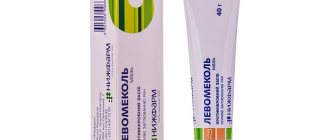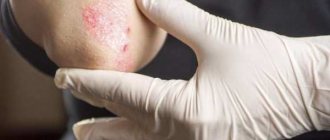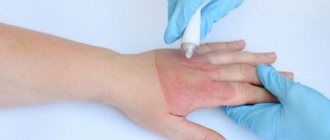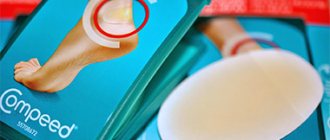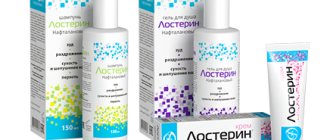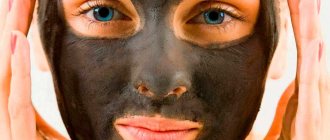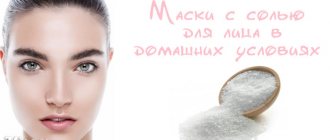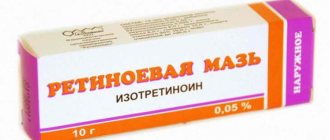In what cases is it prescribed
The ointment is used to treat:
- burns of II, III degree;
- necrosis;
- hemorrhoids;
- stomatitis and periodontal disease;
- bedsores;
- trophic ulcers;
- acne, boils and pimples;
- purulent otitis;
- rhinitis and sinusitis;
- frostbite;
- diseases of the genitourinary system.
The ointment is used after surgical operations on wounds obtained after opening ulcers, on calluses.
Comparison of Levomekol ointment with other products
Comparison with Vishnevsky ointment
If you are already using Vishnevsky ointment, and it works effectively, then there is no point in changing it to another product. If you are just choosing a remedy for the treatment of boils, then experts recommend Levomekol as an ointment that leads to the opening of the abscess as quickly as possible. In addition, it has a stronger antibacterial effect and healing properties. And besides this, Vishnevsky’s ointment has a very specific, sharp, unpleasant odor for many people, while Levomekol smells practically nothing.
Comparison with Levosin
Levosin, in addition to the two active components of Levomekol, also contains an analgesic (painkiller) substance. The regenerating and antibacterial effects, which are the most important in the treatment of boils, are approximately the same for both ointments. Based on reviews from people who have used both drugs, we can conclude that Levosin and Levomekol are almost identical and you should choose the one you like based on price, availability in the pharmacy, or your individual preferences.
According to research, when using ointments to treat the same diseases, no advantage of one drug over another was established. However, if the boil is accompanied by severe pain, it is more reasonable to use Levosin, which relieves pain without the separate use of analgesics.
Comparison with Voskopran
Voskopran is a ready-to-use wound healing dressing impregnated with various ointments, including Levomekol. The dressing itself consists of beeswax, which accelerates wound healing.
The main advantage of the Voskopran dressing is that it does not stick to the open wound at the initial stages of treatment, which allows you to change it painlessly. For this reason, Voskopran is popular mainly in the treatment of diseases or mechanical damage to the skin with a large lesion: frostbite, bedsores, burns, ulcers, etc.
When treating boils, Voskopran with Levomekol is not particularly in demand, since skin damage in this case is minimal.
In what cases should the ointment be used?
The inflammatory process appears when staphylococci multiply intensively against the background of unfavorable conditions for the body. The process takes place in two stages:
- infiltrative – the appearance of inflammation in the form of a red tubercle with pain;
- purulent - ripening and breakthrough of boils.
Levomekol can be used at both stages of boil formation. The product penetrates into diseased tissues through the pores and begins to act:
- inhibits the growth of bacteria;
- removes necrotic masses in the form of pus, accelerates purulent formation;
- regenerates skin cells and tissues, heals the wound after opening;
- accelerates the removal of purulent masses through the hole in the drainage if the boil was removed surgically, and prevents new suppuration;
- improves the functioning of the immune system.
How to treat a sore spot at home
You can get rid of a boil without seeing a doctor. Boils need to be treated continuously until the boil head is completely ripe.
It is recommended to carry out the procedure as follows:
- Treat the site of inflammation with medical alcohol, chlorhexidine or peroxide. To do this, apply a few drops of the product to a napkin or cotton pad, wipe the inflammation with light movements from the edge of the redness to the middle towards the core of the boil. Under no circumstances should you push or push!
- Heat the ointment to a temperature of 35 degrees. The consistency will become liquid, it will be more convenient to apply it to the skin or a napkin.
- Apply a thin layer of Levomekol to the inflamed skin, cover with a napkin, and apply a bandage.
- It is allowed to make a compress using gauze, bandage and ointment. Apply a thin loose layer of ointment to the boil. Don't rub! Cover the inflammation with several layers of gauze. Also secure with a bandage or adhesive bandage.
- The bandage must be changed 3 times a day, preferably at the same time. To do this, remove the bandage, remove the remaining Levomekol from the sore spot, disinfect, apply ointment, and fix the compress. Carry out manipulations until the wound is completely cleansed and healed. The usual course of treatment lasts 2–5 days depending on the inflammation.
Another way to treat the surface of a boil is without compression. Clean the wound of infection, apply ointment to the boil, rub it into the inflamed skin until dry. Movements should be performed carefully and very carefully so as not to increase pain.
With proper treatment, the inflammatory process will decrease, pain will go away, and the diameter of the redness will decrease. The abscess will break through in about 3 days. Then the ointment must be placed directly into the wound so that the pus comes out and the wound begins to scar.
If after all the procedures performed within 5 to 7 days, the boil remains and the situation has not improved, you should visit a professional dermatologist. The therapy will contain antibiotics, gels, and ointments in combination.
Analogues according to the principle of operation
The most effective and popular analogues for medicinal properties are “Ichthyol ointment” and “Balsamic liniment according to Vishnevsky”. They also have a pulling principle of action, but have their own characteristics in application.
Analogues of Levomekol against acne
“Ichthyol ointment” is a powerful antiseptic that also has an anti-inflammatory effect. The drug is used in the treatment of dermatological diseases of an infectious-inflammatory nature, which include furunculosis. The main active ingredient is ichtamol, which suppresses the pathogenic activity of bacteria.
Another equally painful property of a local medicine is its analgesic effect. “Ichthyol ointment” promotes rapid stretching and healing of wounds, which has made it no less popular in the treatment of furunculosis than “Levomekol”.
The drug promotes less production of pus, effectively cleansing the affected areas. The active agent does not penetrate the bloodstream, which explains the high safety of the ointment.
The method of use is similar: a small amount of the substance is applied to sterile gauze, which is then fixed with a plaster or any other convenient method. It is recommended to change dressings every 8-12 hours. The duration of use largely depends on the severity of the inflammatory process. The ointment usually allows the wound to heal completely in 1-1.5 weeks.
“Balsamic liniment,” which everyone knows as Vishnevsky’s ointment, has strong drawing properties. The use of liniment is relevant in cases where the boil cannot mature for a long time and its stem in the form of a head does not appear. The medicine contains only natural ingredients, including birch tar, castor oil and xeroform. These active ingredients have antibacterial, anti-inflammatory and regenerating effects. In addition, the drug can effectively relieve pain caused by the inflammatory process in the tissues.
It is recommended to apply dressings with liniment every other day until the boil develops. After this, it is more advisable to replace the drug with Levomekol and Ichthyol ointment.
Despite its fairly safe composition, the drug has contraindications. It is not recommended for use in case of individual intolerance to the medicinal components. It is also prohibited from use in cases of serious renal dysfunction.
With prolonged use of liniment, allergic reactions in the form of urticaria may occur, which requires discontinuation of the drug.
Duration of treatment
Factors on which course therapy with Levomekol depends:
- Local and general immunity
. The inflammatory process begins against the background of weakened immunity. The better the functioning of the immune system, the faster the body will cope with the infection. The patient recovers after 5–7 days when treated with Levomekol. - Severity of the disease
. When one boil forms, the course of treatment ends in a short time. If staphylococci multiply in several places at the same time, furunculosis appears. The disease affects different parts of the body, painful purulent acne develops with intoxication syndrome, which the body does not cope well with. Treatment of furunculosis usually takes two to three weeks. - Chronic and acute diseases of other types
. If a patient suffers from diabetes, he has problems with the functioning of the circulatory system, and the reparative properties of the epidermis are reduced. In such cases, long-term treatment with ointment is prescribed, under the supervision of a doctor, with periodic blood tests.
Reasons for appearance
Before treating boils, it is necessary to get a general picture of the disease. Inflammation of the hair follicles and surrounding tissues, due to staphylococcal infection entering the wounds, is called a boil.
The main provoking factors for the occurrence of the disease include:
Inflammation of the hair follicles and surrounding tissues is called a boil.
- failure to comply with basic rules of personal hygiene;
- the presence of small scratches, abrasions, wounds on the skin;
- diabetes;
- abuse of alcoholic and low-alcohol drinks;
- smoking;
- chronic diseases in the patient's history;
- previous infectious diseases;
- wearing clothes made of synthetic materials or the wrong size;
- prolonged hypothermia or overheating;
- increased sweating;
- increased work of the sebaceous glands;
- increased body weight with transition to the stage of obesity;
- disruption of the endocrine system;
- constant psycho-emotional stress;
- low levels of vitamins and minerals in the body;
- food diet, with an emphasis on fried, spicy, salty foods;
- increased consumption of chocolate;
- untreated insect bites.
Any of these factors can trigger the appearance of boils on the body. In the acute stage of the disease, the appearance of single formations is noted, in the chronic stage - multiple ones. If timely treatment is refused, boils can develop into carbuncles - merging with each other, creating areas of inflammation the size of a child's palm.
Side effects
An inexpensive product with an antibacterial effect contains quite effective active ingredients, but gives a minimum of unwanted reactions if the instructions for use are not followed.
The ointment causes allergies if the patient's body is sensitive to the substances of the drug. The reaction manifests itself on the skin in the form of burning, scratching (urticaria), the appearance of redness and blisters, and general weakness.
With an increased dosage, as a result of a long course of getting rid of boils, hyperemia and itching occur in the area of inflammation.
One of the rarest phenomena associated with the use of Levomekol - angioedema shock - is dangerous due to its symptoms. Shock causes shortness of breath, the face and neck begin to swell, and the patient may die if the ambulance on duty is not called in time.
In all cases, you should avoid applying the ointment and consult your doctor for advice and prescription of an antihistamine and subsequent treatment.
Levomekol for boils
The combined drug Levomekol, which contains an antibiotic and an immunostimulating component, is effective for the treatment of boils. It destroys pathogenic bacteria: gram-positive, gram-negative, spirochetes, chlamydia, staphylococcus, rickettsia, anaerobic, aerobic bacteria, strains resistant to penicillin antibiotics. They cause inflammation on the skin, called a boil.
Levomekol ointment is effective in the treatment of boils on the face, burns, purulent wounds, abrasions, bruises, swelling after injuries, trophic ulcers, stye on the eyelid. When treating boils, it has an anti-inflammatory, antiseptic, healing effect, and can easily draw out pus.
Thus, there is no need to wait 4-5 days for the boil to burst. Literally a few days after using Levomekol, only slight redness will remain from inflammation.
Composition and properties
Levomekol ointment includes 4 components:
- purified water is the basis of the drug;
- methyluracil stimulates the body's protective properties, enhances cellular regeneration, healing, and relieves inflammation;
- chloramphenicol is an antibiotic, an active component that destroys many types of pathogenic flora, when applied externally, it is not absorbed into the bloodstream;
- polyethylene oxide 400 and 1500 – excipient.
The properties of Leovmekol ointment allow the product to be used in a wide variety of branches of medicine:
- dehydrating ensures the removal of excess fluid;
- anti-inflammatory – relieves redness and inflammation;
- antiseptic – destroys pathogenic bacteria, strains, cocci;
- regeneration ensures rapid healing of the skin and mucous membranes;
- drawing out pus;
- immunostimulating has a positive effect on local immunity, increasing the protective functions of the epithelium.
Indications for use
Levomekol ointment is a universal medicine that is used in the treatment of such disorders:
- Dermatology: acne, boils, abscesses, swelling, infected, purulent wounds, burns of various degrees, cuts, insect bites, abscesses, bedsores, injuries, abrasions.
- Ophthalmology: external, internal stye, conjunctivitis.
- Surgery: postoperative sutures (to avoid suppuration and infection).
- In otolaryngology it has been used for otitis media and sinusitis.
- Gynecology: gonorrhea, dysbiosis, thrush, vaginosis, vaginitis, cervical erosion, salpingitis, colpitis, genital herpes.
- In proctology, there is a frequent use of ointment for hemorrhoidal cones (in complex therapy with agents that have an antithrombic effect).
Therapeutic effect
Getting on the boil, Levomekol destroys the bacteria that caused the development of the abscess. The ointment also envelops the abscess, drawing out pus from it and relieving inflammation. At the final stage, it promotes healing and restoration of the skin.
Levmekol has the following effects:
- Relieves burning sensation.
- Kills pathogenic microbes.
- Stimulates the protective properties of the skin.
- Heals the epidermis and mucous membranes.
- Has an anti-inflammatory effect.
- Strengthens metabolism.
Instructions for use
For boils, Levomekol ointment should be applied to a purulent, inflamed abscess in a thick layer. Cover the boil with a sterile cloth and bandage. Leave for 2-3 hours. Change the napkin twice a day.
After a few days, the inflammation and swelling will subside, the pus will come out and the healing stage will begin. Continue to apply the drug to the burst boil for another day.
Levomekol ointment can be used not only for boils. The medication is applied pointwise to acne and styes on the eyelid. In the form of tampons, the product is inserted vaginally and rectally. A tourniquet moistened with the drug is placed in the ear canal or nostrils. Apply bandages with Levomekol for wounds, burns, abrasions, trophic ulcers, and large areas of skin damage.
You can find out about the duration of the course from the instructions for using the ointment or from your doctor. Often it does not exceed 14 days due to the presence of an antibiotic.
Overdose and side effects
Levomekol is not recommended for use in quantities of more than 3 grams per day. Large wounds are not an exception.
No cases of drug overdose have been previously identified. In general, the product can be considered safe. When used externally, it is not absorbed into the bloodstream.
Rarely, side effects such as redness, burning, itching are possible. This may be caused by an allergic reaction to the component methyluracil.
special instructions
Levomekol ointment can be used in childhood, but not earlier than 3 years. During pregnancy, the product will not cause harm when used externally. Doctors may even prescribe medicated tampons if the risk to the fetus is greater than the harm to the pregnant woman.
Contraindications
Levomekol is a medical drug, so it has contraindications. The following categories of patients cannot treat boils or treat wounds after opening a boil:
- women in the first trimester of pregnancy during the development of fetal organs and the formation of the placenta;
- newborns and children under one year old, so as not to get intoxicated;
- people with individual intolerance to ointment elements;
- for fungal skin diseases such as psoriasis, eczema, etc.
Indications
Levomekol is an effective remedy for the care of damaged skin. Dermatologists and cosmetologists usually recommend ointment to people who are concerned about:
- skin abrasions;
- wounds with suppuration;
- postoperative sutures;
- postpartum ruptures in women;
- inflammatory processes and erosions in the female genital organs;
- the appearance of cracks;
- acne and single acne;
- scratches;
- inflammatory processes on the skin;
- erosion;
- boils;
- ulcers on the skin.
Contraindications
Levomekol ointment for acne and other skin problems is not prescribed to people who are allergic to its components.
Features of application
- Pregnant women should consult a doctor before using the ointment. He will decide whether it is worth using the drug to get rid of purulent formations or prescribing similar medications that can cope with the disease. For extensive purulent wounds, Levomekol is not recommended. It contains an antibiotic that can penetrate the blood and placenta if used in large dosages.
- Only a doctor can prescribe the product to nursing mothers if there are serious concerns about the mother’s health. To minimize the risk for the baby, you can transfer the newborn to artificial feeding during the treatment period.
- When serious purulent inflammation appears on the skin of the face, you need to seek help from a specialist. After the examination, the dermatologist will prescribe a comprehensive treatment that will not lead to the formation of unsightly scars on the face in case of improper treatment with ointment and will not allow the infection to spread into the deep layers of the skin and tissue.
- In severe cases of the disease, doctors resort to surgical removal of boils. In such cases, Levomekol is used after surgery to treat and scar the wound and prevent the formation of new suppurations.
Baneocin or Levomekol: which is better?
Let's try to compare the drugs
Baneocin has a larger list of indications for use, so it is better to use this ointment:
- For boils
- For carbuncles
- For sycosis
- For hidradenitis
- Etc. (see indications)
At the same time, Baneocin has more contraindications, so Levomekol would be the best choice for:
- Extensive skin lesions
- Disorders of the excretory system
- Infections affecting the ear canal
- Hypersensitivity to neomycin and other components of Baneocin
In addition, it is much more effective to use Levomekol exclusively for the treatment of purulent wounds or, for example, after circumcision, due to the fact that in its composition, in addition to the antibiotic, there is also a reparative (restorative) component - methyluracil, which accelerates tissue healing after surgery.
Precautionary measures
Levomekol is a local external remedy. It should be applied with caution.
- If the ointment gets into your eyes, they should be rinsed with water. If the medicine gets inside, the victim needs to rinse the stomach and give absorbent medicines.
- After treating the wound, you should wash your hands thoroughly with soap.
- You can treat the boil with ointment up to 4 times a day. An overdose of the drug has not been noted, however, the drug may cause an allergic reaction, and treatment will have to be interrupted.
- When treating inflammation with Levomekol, other medications should not be used.
- Course therapy can be carried out for up to 10 days. If further treatment is required, you should visit a doctor - only he can indicate further procedures. When using the ointment for a long time, patients should have their blood tested.
Analogues of the drug for the treatment of boils
Boils can be treated with various means. Depending on the principle of action, they are used at different stages of the disease.
When inflammation occurs, the affected area is lubricated with Tetracycline, Ichthyol ointment, Synthomycin, Baneocin, Bactroban or Oflocaine. The listed drugs help the rod mature and reduce pain.
After the boil has matured and broken through, Vishnevsky or Zinc ointment, Solcoseryl, or any product with Panthenol will be suitable. They will help remove the remaining pus, dissolve the compaction on the skin and help the wound heal.
Analogues and substitutes for furunculosis
Instead of Levomekol, other drugs can be used in the treatment of boils. The action is similar, but at several stages of chiria maturation you will have to use different ointments.
At the initial stage of the inflammatory process, when the rod is not mature, the following means can be used:
- ichthyol ointment. The drug with natural ingredients accelerates the ripening process of chiria;
- tetracycline ointment. Antibacterial agent effective in the treatment of purulent inflammation;
- Baneocin consists of two antibacterial drugs that have been successfully used in the treatment of skin inflammation;
- syntomycin contains chloramphenicol and can be used in the treatment of chiries;
- oflocaine. In addition to the antimicrobial ofloxacin, it contains an analgesic component. Treats skin inflammations, ulcers, boils;
- Bactroban is a product for external use with a pronounced antimicrobial effect and is well tolerated.
At the stage of opening the boil and releasing pus, the following drugs can be used:
- Vishnevsky. It draws out pus well from affected cells. Has a pronounced odor;
- zinc ointment. Has an antiseptic effect, dries the skin, accelerates healing;
- solcoseryl. It has a pronounced regenerating effect due to the activation of metabolic processes in cells.
When the purulent core has come out, but the wound is fresh, doctors recommend creams Bepanten, Gentaxan, Dexpanthenol, Pantoderm and other products containing healing panthenol for the regeneration of skin cells.

